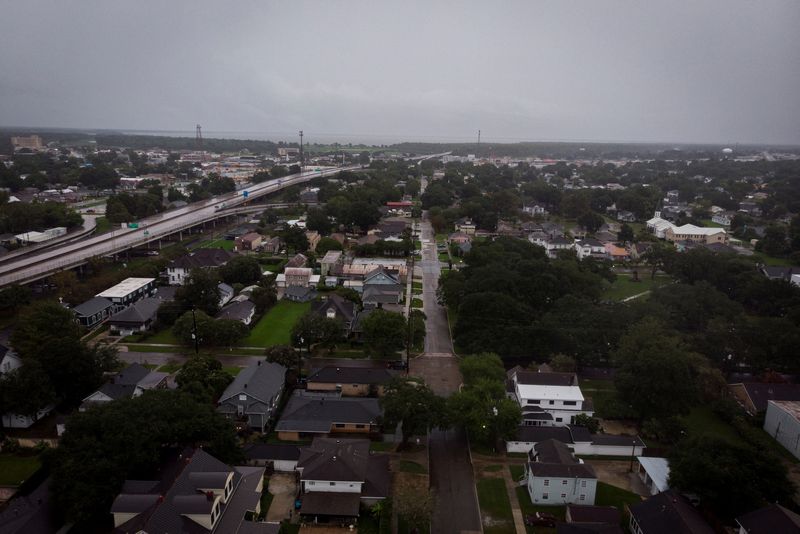
By Ned Randolph
NEW ORLEANS (Reuters) -Hurricane Francine threatened New Orleans and the wider Gulf Coast on Wednesday, shutting down a quarter of oil and gas production in the Gulf, while parishes across Louisiana issued evacuation orders ahead of expected pounding winds and heavy rains.
The hurricane was about 150 miles (240 km) southwest of Morgan City, Louisiana, as it crawled northeast packing 90 mph (145 kph) winds, according to an advisory from the U.S. National Hurricane Center.
The storm was a Category 1 hurricane, the weakest on the five-step Saffir-Simpson scale, but still dangerous and requires preventative measures. It was expected to make landfall on Wednesday night in south-central Louisiana, the National Weather Service said.
Louisiana Governor Jeff Landry, who declared a state of emergency in anticipation of the storm, urged residents to take necessary precautions to ride out the storm in their homes.
“It is on our doorstep. After the storm is over, please remain in place,” he said during a press conference on Wednesday. “Stay off the roadway.”
The service warned that conditions were expected to deteriorate throughout the day as the hurricane threatened some coastal areas with 10-foot (3-meter) storm surges.
“Make sure you have all preparations rushed to completion ASAP!,” the service said on X. “Then, prepare to hunker down & shelter in place through the overnight hours.”
The service issued storm surge watches or warnings along the Gulf Coast of Louisiana, Mississippi and Alabama.
About 200 miles (322 km) west of New Orleans in coastal Cameron Parish, Louisiana, a worker at Bayaks County Store said the establishment would remain open for a few hours on Wednesday morning for anyone who needed last-minute supplies. But no one had visited the store.
“The store is open, but we have no customers,” the clerk said. “Everyone ran out of town.”
About 115 miles (185 km) to the east in Morgan City, a curfew was set until 6 a.m. Thursday, the small city’s police chief, Chad Adams, told the media.
“We want everybody to just kind of shelter in place,” he said of the city’s 11,000 residents.
President Joe Biden also declared a federal state of emergency for the state in order to expedite any needed relief or rescue efforts.
Any major storm near Louisiana evokes memories of Hurricane Katrina, the 2005 storm that devastated New Orleans and surrounding areas, killing nearly 1,400 people and causing $125 billion in damage, according to a 2023 hurricane center report.
Several parishes, or counties, on or near the Louisiana Gulf Coast earlier issued mandatory evacuation orders, and the state transportation department issued evacuation maps. The city of New Orleans was distributing sandbags at five sites.
After distributing tarps, fuel cans and canned food to about 300 families on Tuesday, New Orleans charity Below Sea Level Aid shut down efforts on Wednesday because the storm was too close, said the group’s executive director Jack Waguespack.
“We expect to open up again tomorrow after the storm passes and we’ll go where the need is,” Waguespack said.
Francine was expected to produce rainfall of 4 inches (10 cm) to 8 inches (20 cm), with local amounts of up to 12 inches (30 cm) for the central and eastern Gulf Coast through Thursday night, the weather service said.
In Dulac, a coastal fishing community 70 miles southwest of New Orleans, fisherman Barry Rogers (NYSE:ROG), said he planned to ride out the storm on his 80-foot-long shrimp boat rather in his home.
“The house is not going no where. If it does, there’s nothing you can do about it,” he said. “If a rope breaks on the boat, I’d rather be there to tie up another one.”

With the storm passing in a northeastern direction parallel to the Texas coast on its way to Louisiana, oil and gas drillers evacuated many of their Gulf of Mexico platforms, taking offline about a quarter of energy production, the U.S. Bureau of Safety and Environmental Enforcement said on Tuesday.
The storm also stands to test liquefied natural gas export plants recently built in the region, which is home to about 15% of U.S. oil production and 2% of natural gas output.
This post is originally published on INVESTING.



